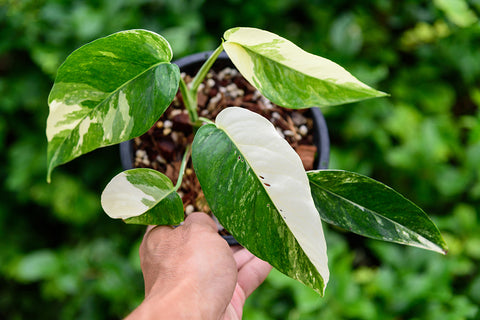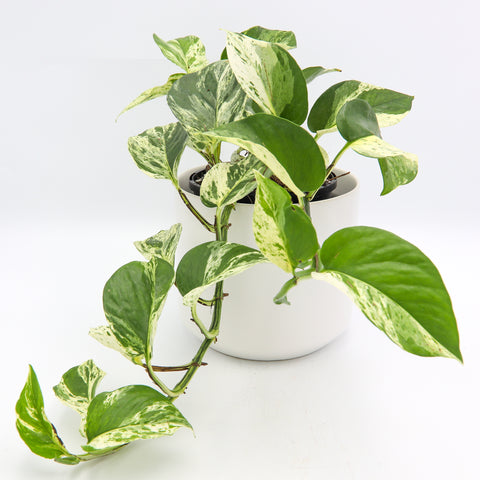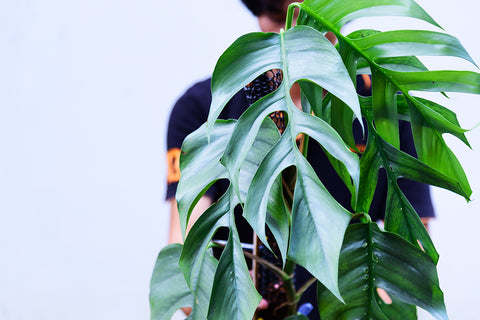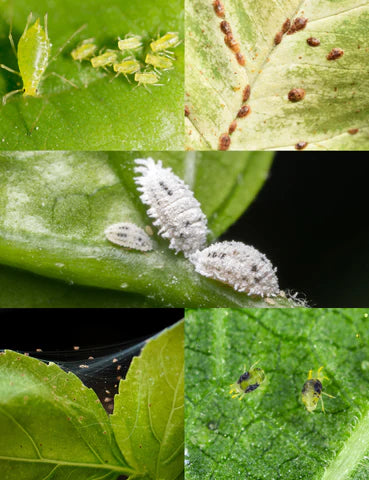Epipremnum Plant Care Guide
HOW TO GROW AND CARE FOR EPIPRMNUMS
By Julianne Blackaby | 25/09/2023

📷 Epipremnum aureum 'Manjula', Chalet Boutique
| Common Varieties | Devil's Ivy, Pothos, Marble Queen, Neon Pothos, Golden Pothos, Manjula, Silver Satin Pothos, and Jade Pothos. |
| Botanical Name | Epipremnum sp. |
| Family | Araceae |
| Plant Type | Tropical vine |
| Mature Size | Up to 18 meters tall |
| Light | Bright, indirect light |
| Soil Type | Chunky aroid mix |
| Native Areas | Asia, Australia |
| Toxicity | May be toxic to dogs and cats |
Epipremnums are tropical plants known for trailing or climbing vines and thick leaves. They are native to tropical forests from China, the Himalayas, and Southeast Asia to Australia the western Pacific and can be found in many other tropical climates worldwide. Epipremnums are popular for their ease of care, adaptable light tolerance, and ability to thrive in moist soil mixes. They are also known for their astonishingly rapid growth. Epipremnum make excellent houseplants and are often used in hanging baskets or climbing growing poles.
Our guide will provide all the information you need to keep your Epipremnum plants healthy and thriving. We will give you tips for their light and temperature needs, watering and fertilising, and how to propagate your plant. Let's embark on the journey of Epipremnum plant care together!
WELCOME TO YOUR COMPLETE GUIDE TO CARING FOR EPIPREMNUMS

📷 Epipremnum pinnatum 'variegated'
How much light does an Epipremnum need?
Epipremnum plants need bright, indirect light to thrive indoors. Direct sunlight should be avoided to prevent sunburn. Place your plant in a spot that is away from direct sunlight but still gets plenty of bright, indirect light. Most Epipremnums prefer an area facing a window with a light curtain cover.
HOW OFTEN SHOULD I WATER AN EPIPREMNUM?
Ensure that your plant actually needs watering before proceeding. Epiprenmums require watering when the top 3-5cm of soil has dried out. The watering frequency will vary depending on your home's temperature and humidity levels, which could range from every 7-10 days. During the warmer summer months, it is advisable to water your Epipremnum more often than during the winter. Take care to check the soil for dryness before watering, and avoid overwatering, as this can result in the plant becoming waterlogged or the roots decaying.
WHAT IS THE BEST POTTING MEDIUM FOR EPIPREMNUM?
For Epipremnum, it is recommended to use a well-draining aroid mix consisting of chunky orchid bark, perlite, horticultural charcoal, coco coir, and premium potting mix. When choosing a pot or planter, ensure it has drainage holes at the bottom to facilitate the easy drainage of excess water.
WHAT IS THE BEST TEMPERATURE FOR EPIPREMNUM?
Epipremnums generally thrive in a temperature range of 15-29°C. They can tolerate slightly lower temperatures but are sensitive to cold drafts and temperatures below 10°C, which can damage their foliage. Additionally, high temperatures above 29°C can cause stress to the plant and result in leaf discolouration or leaf drop. Therefore, it is best to maintain a consistent temperature within the recommended range to ensure the healthy growth of your Epipremnum.
WHAT IS THE BEST HUMIDITY FOR EPIPREMNUM?
Epipremnums prefer moderate to high humidity levels, ideally between 50-70%. However, they can tolerate lower humidity levels, especially if the air is not too dry for extended periods. Low humidity can cause leaf tips to turn brown, while high humidity can lead to fungal growth and pest problems. To maintain the ideal humidity level, place a humidifier nearby or group it with other plants to create a microclimate with higher humidity.

📷 Epipremnum aureum 'Marble Queen'
TRAINING EPIPREMNUM ONTO A TRELLIS OR Grow POLE
Epipremnums are easy to train onto a trellis or pole, and doing so can enhance their growth and appearance. Here are the steps you can follow to prepare your Epipremnum to grow onto a trellis or pole:
- Choose a sturdy trellis or pole tall enough to support the growing plant. The trellis should be made of a material the plant can easily attach itself to, such as bamboo or plastic.
- Position the trellis inside the pot, so it is directly in contact with the soil, ensuring it is stable and secure.
- Gently guide the plant's stems towards the trellis or pole, not damaging the leaves or roots.
- Use plant ties to attach the stems to the trellis or pole. Ensure the ties are not too tight and do not damage the stems.
- As the plant grows, guide its stems towards the trellis or pole and secure them with ties.
- Prune any stems not growing towards the trellis or pole, as this will encourage the plant to focus its energy on the trained stems.
- Water the plant regularly and fertilise it once a month to encourage healthy growth.
Following these steps, you can train your Epipremnum onto a trellis or pole, creating a beautiful and healthy plant to enhance any room or outdoor space.
WHAT ISTHE BEST FERTILISER FOR EPIPREMNUM?

Growth Technology Foliage Focus is an excellent choice for fertilising Epipremnum plants. This balanced, liquid fertiliser is specially formulated for foliage plants, providing all the necessary nutrients for healthy growth and vibrant foliage. Foliage Focus contains a blend of macro and micronutrients and organic compounds, which are readily absorbed by the plant's roots and foliage. The fertiliser is easy to use and can be added directly to the soil when watering. Regularly applying Foliage Focus can help promote healthy growth, prevent nutrient deficiencies, and enhance the plant's resistance to pests and diseases. Overall, Foliage Focus is a reliable and practical choice for keeping your Epipremnum thriving and looking its best.
WHY CHOOSE GT FOCUS?
- The GT Focus range sets the benchmark for liquid nutrients. Here's why:
- Each GT Focus product is complete. Unlike the overwhelming majority of fertilisers, all Focus products contain each of the 12 essential minerals – including Calcium – blended into an easily absorbed liquid concentrate.
- pH buffered to ensure all 12 essential minerals are available to the plant.
- Formulated and balanced to suit the requirements of specific plant types.
- Manufactured using only the highest-grade raw materials and chelated trace elements to ensure effortless absorption by the plant.
- Guaranteed not to contain potentially harmful and ineffective chlorides, urea, sodium and ammonium.
- Easy to use with simple instructions.
- Makes up to 200 litres of working solution

📷 Epipremnum pinnatum 'Cebu Blue'
WHAT ARE COMMON EPIPREMNUM PESTS, AND HOW YOU TREAT THEM?
Epipremnum can be susceptible to various pests, including aphids, mealybugs, spider mites, and scale insects. The use of beneficial insects such as ladybugs, lacewings, and parasitic wasps can be effective biological control against these pests.
Aphids are small, soft-bodied insects that feed on plant juices. They can be identified by their pear-shaped bodies, usually black, green, yellow, or brown. Aphids can weaken the plant by sucking out its sap, leading to yellowing and/or wilting leaves. Treatment for aphids includes spraying the plant with a strong water stream or using an insecticidal soap or neem oil solution.
Mealybugs are small, white, fuzzy insects that feed on plant sap. They are usually found in clusters on the underside of the leaves. Mealybugs can be treated with insecticidal soap or neem oil, or a cotton swab dipped in rubbing alcohol to wipe them off.
Scale insects are tiny, flat, oval-shaped pests that feed on plant sap. They can also be identified by the white, waxy coating they produce. Treatment for scale insects includes wiping them off with a cotton swab dipped in rubbing alcohol or spraying the plant with neem oil.
Spider mites are tiny, eight-legged arachnids that feed on plant sap. They cause yellowing and stippling of the leaves and webbing on the foliage. Treatment for spider mites includes spraying the plant with Kill-a-mite or Stealth. By monitoring these common pests and treating them promptly, you can ensure that your plant stays healthy and continues to thrive.

Top Left: Aphids, Top Right: Scale, Middle: Mealybugs, Bottom: Spider mites
HOW TO PRUNE AN EPIPREMNUM
Identify dead, damaged, or diseased leaves, stems, or roots to prune your Epipremnum. Use sharp, clean pruning shears to make clean cuts, taking care not to damage the healthy parts of the plant. You can also prune to control the plant's size and shape, cutting back any stems growing too long or in unwanted directions. Make sure to prune in spring or summer when the plant is actively growing and can recover from the cuts quickly. Regular pruning can help to keep your Epipremnum healthy and looking its best.
HOW TO PROPAGATE AN EPIPREMNUM
Several ways to propagate an Epipremnum include water propagation, sphagnum moss, perlite, and vermiculite propagation. For water propagation, simply take a stem cutting with several leaves and place it in a jar of water, ensuring the bottom of the stem is submerged. Change the water every few days and wait for roots to develop. For sphagnum moss propagation, wrap a stem cutting in damp sphagnum moss and cover it with plastic wrap to create a humid environment. For perlite or vermiculite propagation, mix with a bit of water to make a damp but not too wet mixture, and plant the stem cutting in the mix. Water and wait for roots to develop. Once roots have formed, plant the cutting in a pot with well-draining soil and care for it like a mature Epipremnum plant.
WHEN DO YOU NEED TO REPOT AN EPIPREMNUM?
Repotting an Epipremnum is necessary when the plant has outgrown its pot or when the soil has depleted its nutrients. It is best to repot when the plant is actively growing. Spring is the best time to repot. If the plant has become too root-bound, it should be re-potted immediately. When repotting, choose a pot slightly larger than the current pot, as too large of a pot will cause the soil to become waterlogged, and the roots may rot. Using fresh potting soil will help to prevent disease and ensure the plant has all the nutrients it needs. When repotting, make sure to keep the root ball intact and to water thoroughly.
WHAT SORT OF POT DOES AN EPIPREMNUM LIKE?
Epipremnum plants prefer a pot with drainage holes in the bottom to ensure that the soil does not become waterlogged. It is also essential to choose a pot slightly larger than the current root system of the plant, as Epipremnum will quickly outgrow a pot that is too small.
ARE EPIPREMNUMS TOXIC TO PETS AND CHILDREN?
Unfortunately, the answer is yes. All parts of the plant contain calcium oxalate crystals, which can irritate and burn the throat and mouth if eaten. Symptoms of ingestion can include excessive drooling, vomiting, difficulty swallowing, and abdominal pain. In severe cases, respiratory problems and tongue and throat swelling may occur. If you have pets or young children in your home, keeping your Epipremnums out of reach is best to prevent accidental ingestion.

📷 Epipremnum aureum 'Shangri La'
A List Of Well-Known Epipremnums
Epipremnum aureum (Devil's Ivy, 'Goldilocks', 'Manjula', 'Marble Queen', 'Pearls & Jade', 'Shangri La', 'Shangri La'.
Epipremnum pinnatum (Dragon Tail Plant)
Epipremnum amplissimum (Giant Epipremnum)
Epipremnum giganteum (Giant Marble Queen Pothos)
Epipremnum pinnatum' Cebu Blue' (Cebu Blue Pothos)
Epipremnum manjula (Manjula Pothos)
Epipremnum njoy (N'Joy Pothos)
Epipremnum' Marble Queen' (Marble Queen Pothos)
Epipremnum silver splash (Silver Splash Pothos)
Epipremnum' Neon' (Neon Pothos)










